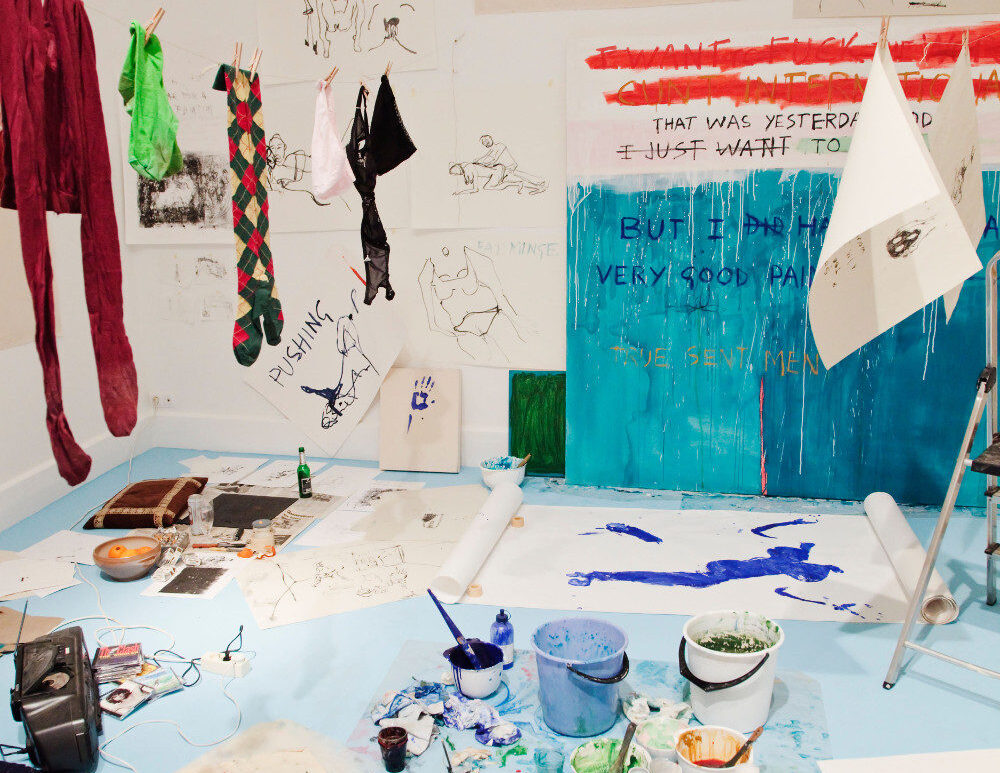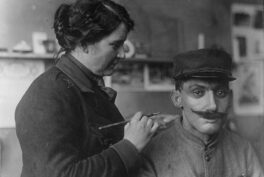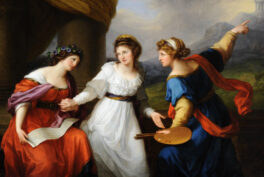Summary
- Tracey Emin is an English-born artist known for her raw emotional honesty, who gained worldwide fame with My Bed. In her work, she explores longing, vulnerability, and the human need for love and desire.
- I Need Art Like I Need God, here as a handwritten artwork, is a central concept in Emin’s practice, equating art with a form of salvation.
- The painting I Wanted Love depicts intertwined bodies expressing vulnerability and the longing to be desired.
- Artist’s iconic neon work Love Poem for CF uses her distinctive handwriting to convey universal emotional resonance.
- True Love Always Wins is a lithograph symbolizing love as a path of sacrifice, growth, and spiritual ascent.
- Exorcism of the Last Painting I Ever Made recreates Emin’s three-week self-imposed confinement in a Stockholm gallery, where she confronted trauma and reclaimed her creative voice.
- You Inspire Me With Your Determination, and I Love You is a lithograph of two birds representing an authentic, peaceful romantic connection.
- Emin’s embroidered work I Can’t Let Go explores emotional attachment, inability to move on, and the solitude of painful experiences.
- I Waited So Long reflects Emin’s view of solitude as both challenging and deeply fulfilling, a space for self-completion and introspection.
- All I Want Is You symbolizes the enduring presence and love of the artist’s late mother.
- You Have No Idea How Safe You Make Me Feel addresses the comfort offered by animals or other sources of emotional safety.
Born in Croydon, London, in 1963, Tracey Emin spent much of her childhood and adolescence in Margate. Later, she settled primarily in London, where she attended the Royal College of Art, graduating in 1989. Worldwide success arrived in 1998 thanks to her work My Bed, which was nominated for the Turner Prize. Besides causing a media sensation, the piece immediately established her as an unprejudiced and unpretentious artist, with no fear in exposing her most intimate secrets and intricate emotions. Let’s take a look at 10 pieces, other than My Bed, to get to know her better.
1. I Need Art Like I Need God, 1998

Tracey Emin, I Need Art Like I Need God, 1998. © Tracey Emin. All rights reserved, DACS 2025. Angie’s Artwork Studio.
There’s no other way to begin when talking about Tracey Emin. This handwritten phrase has a fundamentally revealing meaning: the need for art is equated with God’s salvific power. Here, the technique is rather simple, consisting of a handwritten ink text on a pale white background. Austerity is a hallmark of Emin’s work, which often consists of a few evocative phrases that take on an all-encompassing meaning. In this case, these words convey the full significance of the creative act, its closeness to a true religion, revealing the artist’s infinite devotion to her work. Above all, they underscore the power that art has over humans in bringing them closer to a higher meaning that uplifts their spirits.
I Need Art Like I Need God is also the title of an exhibition that took place at the South London Gallery in 1997, highlighting this concept as a recurring theme throughout Emin’s work. The artist recently stated:
When we talk about painting, art, integrity, what we are capable of, in a good way, we human beings, art is one of the few beautiful things we have left. … And it’s like cultivating a garden, having plants: in nature there are plants, flowers, and trees. But these (the works of art), we created them, we create them. They would never have existed without me. I cultivated them in my mind, with my hands; they come from my heart, from my blood, from my movement. This expresses how I am. And that’s why you perceive emotions and sensations: I don’t try to make it look like that, I am like that.
Interview with the artist by Antonio Galansino for the Sex and Solitude exhibition in Florence, 2025.
2. I Wanted Love, 2024
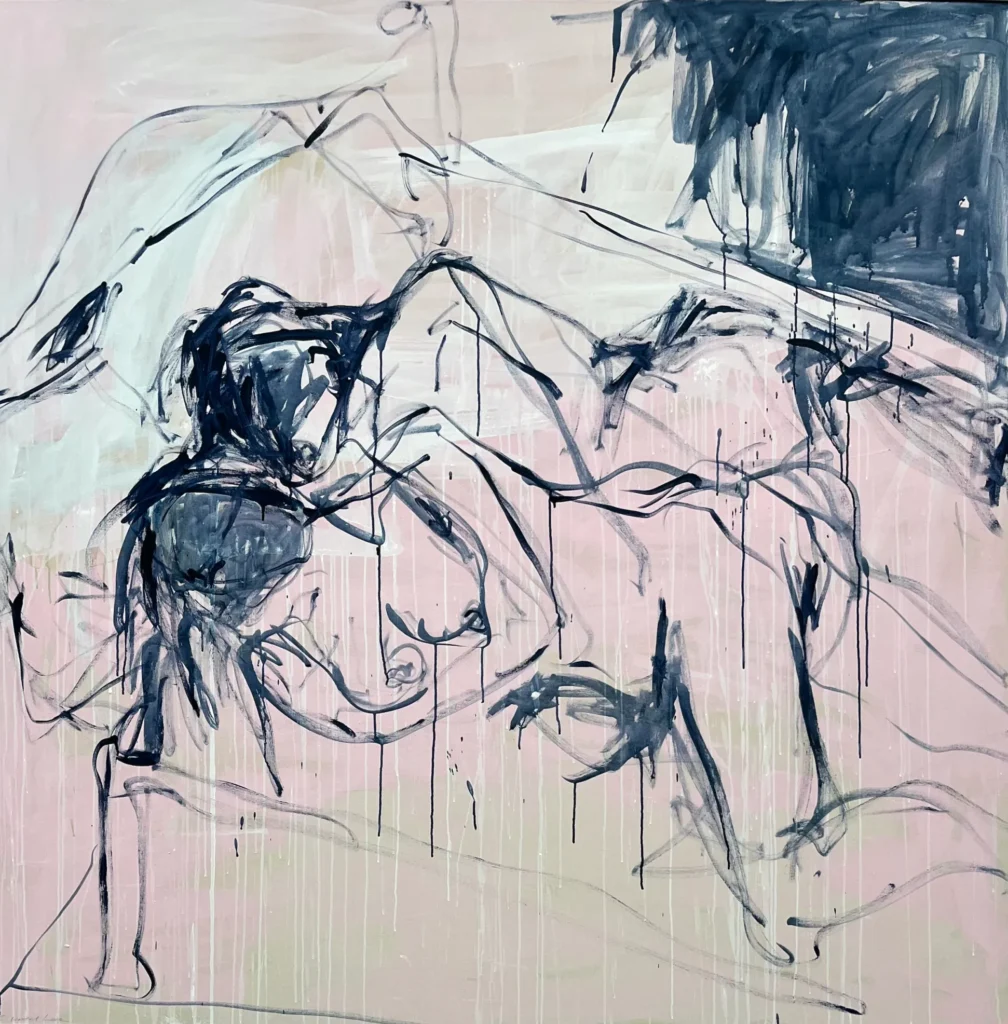
Tracey Emin, I Wanted Love, 2024. © Tracey Emin. All rights reserved, DACS 2025. Hyperallergic.
In this very recent piece, the artist depicts two bodies entwined in a suspended atmosphere. The representation of sexual acts, more generally of love, is constant in her pictorial works. Often, the physical features of the portrayed bodies are not fully visible, especially the faces. The artist has repeatedly stated that she ideally represents herself as the protagonist of the experiences shown, which involve suffering, distance, and perseverance.
This work highlights the desire to be loved and wanted, the human need to feel desired by someone else, both emotionally and physically. The past tense in the title suggests that the artist is recalling a personal experience, where she likely ardently desired to be one with that person, even at the cost of losing part of herself. The piece, in acrylic, develops through shades of white, purple, and blue, and is extremely enveloping, so much so that we perceive the extreme vulnerability of the subjects involved. Emin’s style thus straddles figuration and abstraction, drawing inspiration from, among many artists, Edvard Munch and Egon Schiele, whose work she deeply admires.
3. Love Poem for CF, 2007
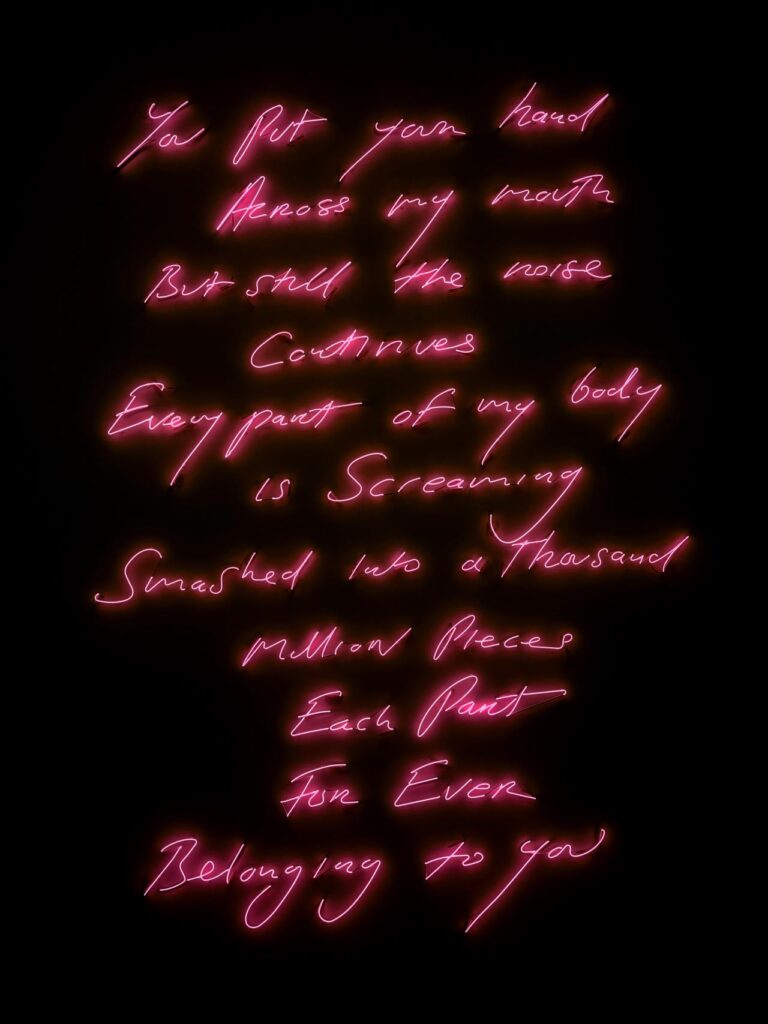
Tracey Emin, Love Poem for CF, 2007, National Gallery of Victoria, Melbourne, Australia.
Here is one of Emin’s most famous neon works, featured in a recent exhibition, Sex and Solitude at Palazzo Strozzi, in Florence. Neon art is a hallmark of her entire artistic oeuvre. One of its great strengths lies precisely in the unique nature of Emin’s calligraphy. Introspective phrases emerge like the soul’s small mosaics: they primarily belong to the artist, but have the power to resonate universally.
Emin has recalled keeping a series of diaries over time, emphasizing the importance of finding a channel of expression for her thoughts through writing. For this reason, especially in her neon works, she carefully chooses phrases that evoke real and palpable atmospheres. In Love Poem for CF, the chosen words awaken the intensity of a loving embrace in its all-encompassing and unrepeatable nature, echoing throughout the bodies. Although addressed to CF, likely a personal acquaintance of the artist, her words resonate so closely that they could be mistaken for our own experiences. Emin entrusts the production of large-scale neon works to a dedicated team that has collaborated with her since the 1990s.
4. True Love Always Wins, 2016
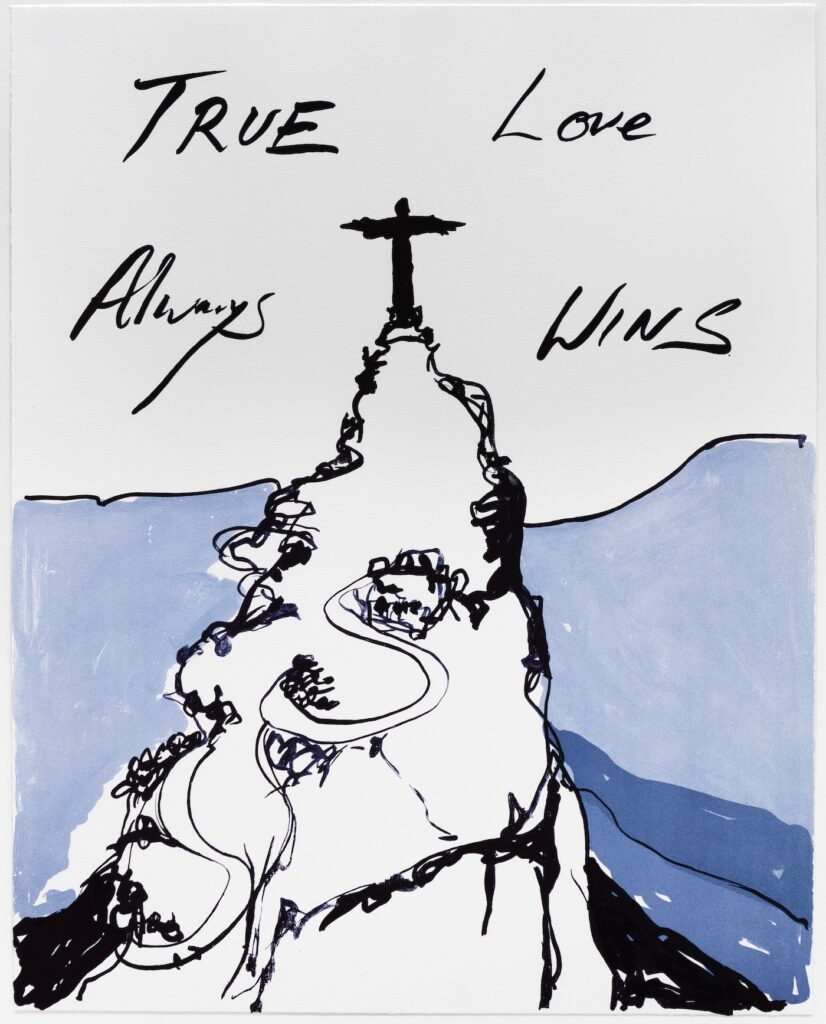
Tracey Emin, True Love Always Wins, 2016. © Tracey Emin. All rights reserved, DACS 2025. Counter Editions.
Another of Tracey Emin’s works, this lithograph on paper is made of a few poignant colors. It features both figurative elements and a caption “True love always wins,” which stands out at the top. Depicting a mountain topped by a cross, joined by an ascending path, the piece suggests that experiencing love may involve sacrifices, compromises, and hardships, making it difficult to align oneself with the other.
The phrase above, however, speaks clearly: true love will always triumph. Perhaps its very essence coincides with constant growth towards something more sacred; it encompasses the possibility of suffering. This very possibility, however, indicates that we are living, that we are putting ourselves on the line, being aware of the need to open our souls to others to better understand ourselves.
5. Exorcism of the Last Painting I Ever Made, 1996
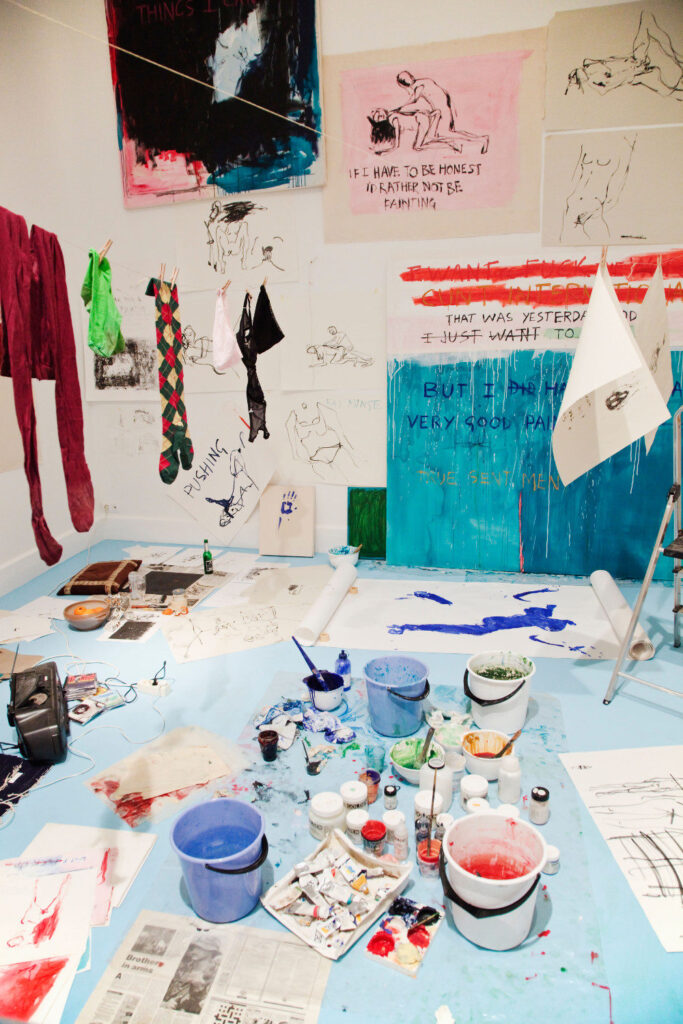
Tracey Emin, Exorcism of the Last Painting I Ever Made, 1996. © Tracey Emin. All rights reserved, DACS 2025. Aware Women Artists.
This installation reproduces the environment in which Emin lived for three weeks in Stockholm’s Brändström Gallery in 1996. The artist had stopped painting for six years due to physical difficulties that arose after two traumatic miscarriages in the early 1990s, particularly the discomfort caused by using oil paints. Emin decided to lock herself away, in a room of the gallery, in order to rediscover a new meaning for her art and painting, and above all, to force herself to test her creativity again. Gallery visitors could observe all this live through a fisheye lens on the wall, meeting the artist and her world.
The space preserves everything she used during her confinement, from the paintbrushes to the cans of beer she consumed, from the clothes she wore to the pots, pans, and glasses. Several Polaroids, currently on display alongside her paintings, portray her naked and intent on working, showing her figure in the surrounding environment, strewn with painting materials.
Looking at the various paintings created during this period, some of which are leaning against the walls, one can sense Emin’s communicative urgency, the need to return to painting to express her inner self again—as the work with the inscription “Some things I just can’t live with and some things I can” suggests. Many of these drawings depict stylized figures paired with inscriptions, which once again engage directly with the figurative style of Schiele, Munch, and Picasso, particularly in the representation of the female subject. We’re far from women’s objectification by the male gaze during the previous centuries: in this case, Emin becomes both artist and model in her own studio.
6. You Inspire Me With Your Determination, and I Love You, 2012

Tracey Emin, You Inspire Me With Your Determination, and I Love You, 2012. Oliver Clatworthy Fine Art.
Here we have a very simple lithograph, depicting two gentle birds touching their beaks. The image evokes a sense of tranquility. Emin looks at romantic connection (not necessarily) as something unique and rare, capable of offering us additional color and luminosity, as we recognize in the other something missing within ourselves, something from which we constantly draw inspiration. Here lies the mystery of love and of all those connections that exude truth. Emin manages to communicate these positive feelings through a few expressive strokes, in a true hymn to everything deeply intimate in the world.
7. I Can’t Let Go, 2007
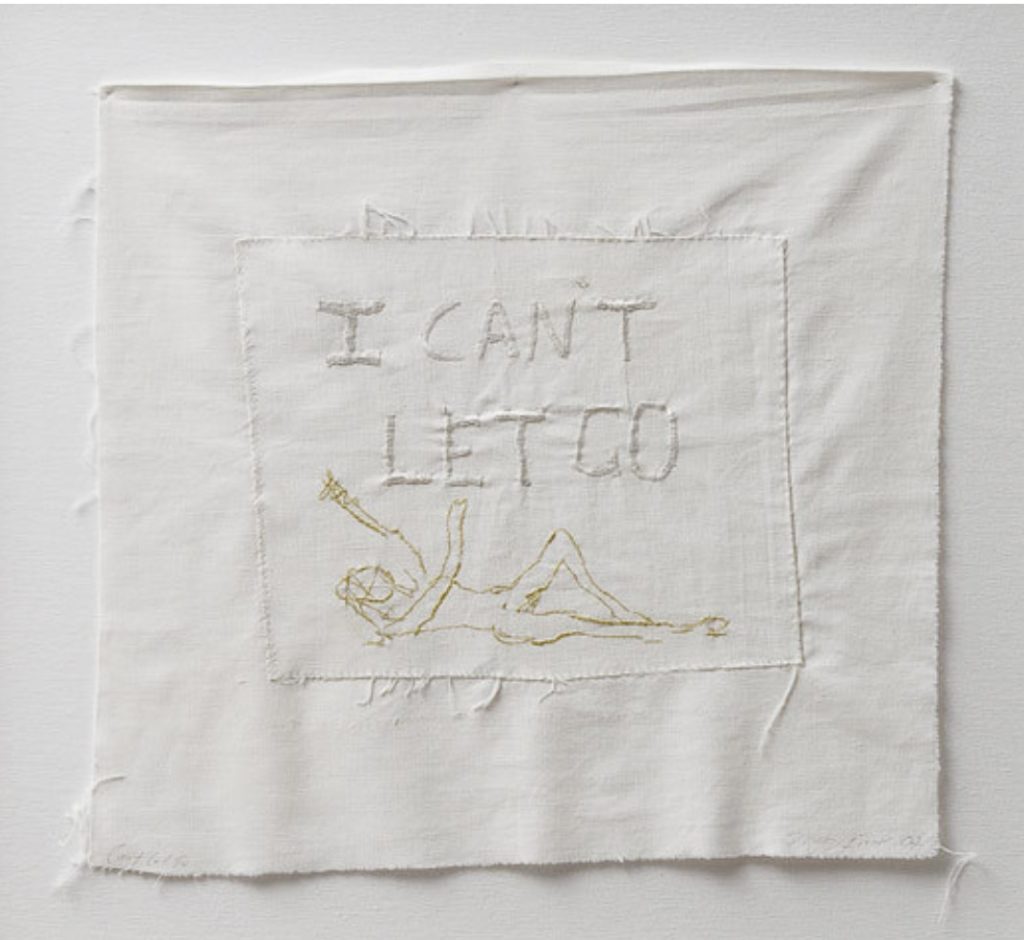
Tracey Emin, I Can’t Let Go, 2007, private collection. © Tracey Emin. All rights reserved, DACS 2025. MutualArt.
Let’s now explore another technique often used by the artist: embroidery. In this particular piece, Emin depicts a female figure—we can assume herself—lying on the floor, topped by the words “I can’t let go”. The work, of a very small size, lingers on a feeling we’ve all experienced in life: being unable to let go of a person or a painful situation that has been particularly meaningful to us. The female figure’s prostration, with one arm raised upward, could indicate her final attempt to cling to something that no longer serves her well. Her staying could signify a final act of love in a self-destructive situation. Emin has often explored these feelings through her work, emphasizing the human solitude that characterizes these moments, the decisions we are often forced to make for our own survival.
8. I Waited So Long, 2022
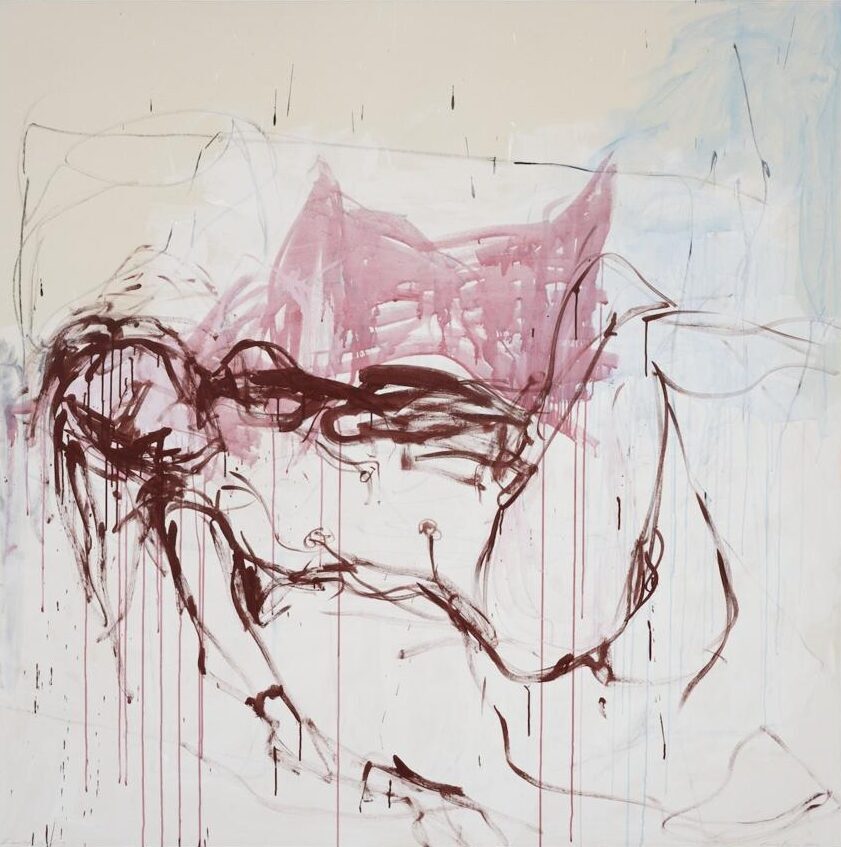
Tracey Emin, I Waited So Long, 2022, private collection. © Tracey Emin. All rights reserved, DACS 2025. Xavier Hufkens Gallery.
This fantastic piece also returns to the theme of solitude, this time visually suggesting the subject’s complete resignation to it. Emin uses one of her signature colors, red, mixing it with white, which serves as the background, a paler red, and finally, blue, in the upper right. Acrylic layers help create a very dense atmosphere. The red intensely colors the scene, highlighting the reclining figure in all her suffering, in complete surrender to the situation and perhaps even to herself. The painting reaches out directly to the viewers, striking them to the depths of their inner being, and leaving them unrestrained by its explosive force.
About the feeling of solitude, Emin said: “I love solitude. When I was younger, I used to think that I was lonely because I felt alone. And I didn’t understand how to use that feeling. I saw it as a negative thing. Now, solitude for me is one of the greatest, most amazing feelings. It’s like understanding nature, understanding time, and being at one with myself. Being totally complete, mentally, physically, and emotionally. And my favorite moment of solitude is painting. When I’m creating, painting, writing, thinking, that’s when I feel fantastic.” Solitude and loneliness are two very different things, and Emin seems here to underscore the value of being with us only, while recognizing it can be very challenging at times.
9. All I Want Is You, 2016

Tracey Emin, All I Want Is You, 2016. © Tracey Emin. All rights reserved, DACS 2025. Xavier Hufkens Gallery.
This sculpture was created by the artist in memory of her mother. Like many of her sculptures, it was crafted in small dimensions and then adapted to larger scales. Emin chose to depict a female body in its sinuous forms leaning against a smaller rock. She explained it symbolizes the ever-present energy of her mother, who had recently passed away when she made the piece. But above all, it represents the unbreakable bond that will always remain between the two—the support, comfort, and love of a mother for her daughter.
Emin’s sculptures, just like her paintings, focus on conveying profound emotions, which are amplified even further by being represented by a female artist, who often places herself as the work’s subject, as in this case. Furthermore, the sculptured bodies bear her clearly visible fingerprints on their surfaces, which contribute to making them more sinuous, imperfect, and therefore vulnerable: in need of care but foremost caring.
10. You Have No Idea How Safe You Make Me Feel, 2013
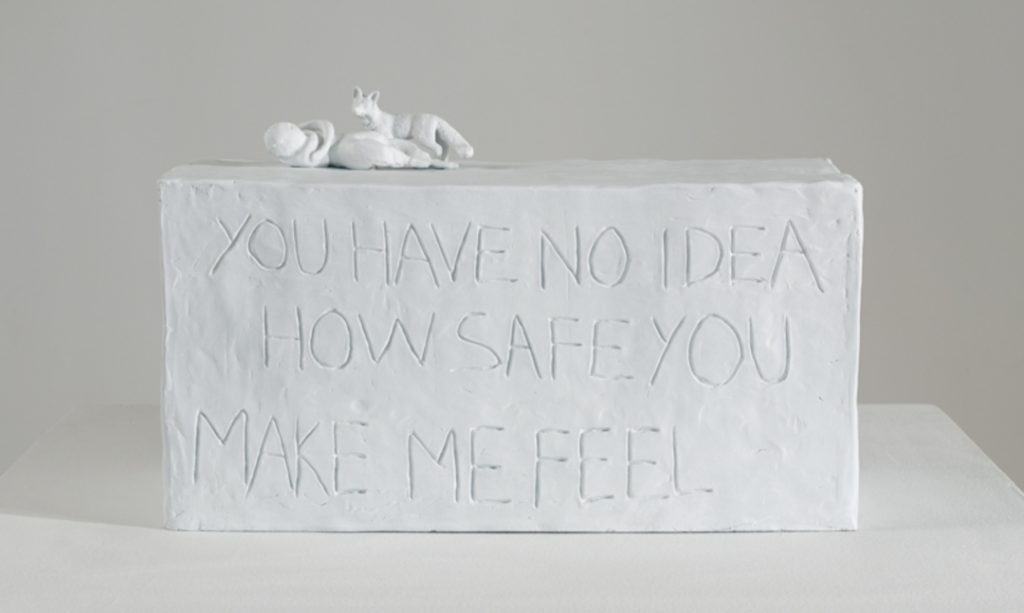
Tracey Emin, You Have No Idea How Safe You Make Me Feel, 2013. © Tracey Emin. All rights reserved, DACS 2025. ArtworkArchive.
This last artwork is part of an enchanting series created by Tracey Emin in 2013, which consists of five rectangular bronze blocks, covered with white patina, on which the artist has engraved a few words, surmounted by small sculptures of various subjects. This one reads, “You have no idea how safe you make me feel.” The little sculpture shows a figure that appears to be a fox or a dog.
Emin is undoubtedly alluding to the reassuring presence animals can be for us humans, being at our side in difficult moments, where even their mere proximity can offer us solace. The work and the phrase can also be read more universally, though, referring to things, people, places, objects: we all have something that instantly makes us feel safer.
Through her production, Tracey Emin offers us a metaphysics of human existence, a prism through which to filter its multiplicity, changeability, and complexity, in the extreme awareness of not being able to sweeten its negative aspects, sufferings, and harshness. Only by embracing them can we live to the fullest, only by accepting them can we put ourselves in the condition of truthfully loving, rejoicing, and letting go. Art can offer shelter; it can allow these feelings to find a home.
Author’s bio:
Giulia Minenna loves modern and contemporary art and loves talking about it. As a philosophy graduate, she tries to reconcile this approach with an artistic one, discovering how art pieces can truly speak to one’s soul.
